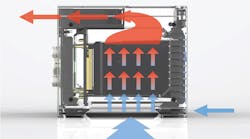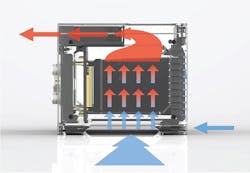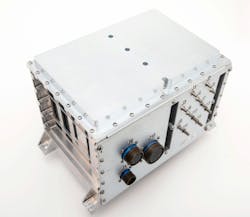ANSI/VITA 48.8 Urges More Convection Cooling for VPX-Based Systems
It’s not news that cooling and thermal management are never-ending issues for systems and their power supplies. Ironically, though, the emergence of smaller components with more processing capability while operating at much lower power has had the counterintuitive effect of actually increasing thermal density, with designers expected to pack even more functionality into ever-smaller spaces.
To accommodate this trend, a newly ratified industry standard encourages increased use of convection cooling and reduces the dependence on conduction cooling for designs using 3U and 6U circuit cards with VPX connectors. ANSI/VITA 48.8 is a mechanical form-factor standard that leverages air-flow-through (AFT) cooling, enabling designers to choose standard-compliant modules from a variety of vendors with the assurance they will be physically (and electrically) compatible.
This specification defines a framework for the design of plug-in modules with AFT cooling while retaining the VPX connector layout. It’s the first open-standard AFT technology that can accommodate small-form-factor 3U VPX modules. These are attractive to military and aerospace applications because they’re particularly sensitive to SWaP-C (size, weight, power, and cost) constraints typified by helicopters and unmanned vehicles.
Subsystems that adhere to the standard can use multiple air-flow arrangements, including air inlets at both card edges, as well as on the top circuit-card edge opposite the VPX connectors (Fig. 1). The standard reduces weight and cost in high-density, high-power electronic systems by eliminating wedgelocks and card-insertion/ejector retainers (levers), and instead replaces them with lighter-weight jackscrews that lock the cards into a subrack chassis. Further, since it’s less dependent on module-to-chassis conductive thermal flow, it promotes use of polymer or composite materials, as well as additive-manufacturing technologies, to reduce overall chassis size and weight.
1. The ANSI/VITA 48.8 standard encourages use of convection rather than conduction cooling, for lighter systems and increased thermal-capacity ratings. Among its attributes are multiple air-inlet paths. (Source: Curtiss-Wright Defense Solutions)
Conduction vs. Convection
Most conduction-cooling approaches remove heat via a physical path from the hot components, through the circuit card, through the card wedgelocks, through the chassis walls, and out to ambient air. In contrast, AFT cooling uses a heat exchanger integrated into the structural frame of each circuit card. Unlike the use of cooling air impinged directly on the components and circuit boards, the AFT plug-in module employs a finned heat-exchanger frame located within the central section of the assembly to top-cool the primary circuit-board components as well as mezzanine-board components.
There’s a design tradeoff, though, of circuit-card pitch compared with more conventional approaches that focus on conduction cooling. ANSI/VITA 48.8 requires larger card-slot pitches of 1.0, 1.2, and 1.5 inches. The standard also specifies the use of gasketing to avoid particulate contamination that results from the airflow.
2. Systems based on ANSI/VITA 48.8 are already available, such as this 3U VPX COTS system with air-flow-through cooling. (Source: Curtiss-Wright Defense Solutions)
Formally known as ANSI/VITA 48.8-2017, “Mechanical Standard for Electronic VPX Plug-in Modules Using Air Flow Through Cooling” was developed and promoted by a working group sponsored by Lockheed Martin, Curtiss-Wright Defense Solutions, and Abaco, and chaired by Curtiss-Wright Defense Solutions (copies of the standard can be purchased via the VITA online shop). Although it’s just now formally ratified, the standard is already in use in systems such as Lockheed Martin's Sikorsky S-97 Raider, and Curtiss-Wright demonstrated an AFT-cooled, 3U VPX COTS system in 2016 (Fig. 2).
For more information:
VITA (until 2005, the VMEbus International Trade Association), “ANSI and VITA Ratify ANSI/VITA 48.8 Air-Flow-Through Cooling Standard for VPX”
Curtiss-Wright, “3U AFT (Air Flow Through) - Why do we need another cooling standard?”



